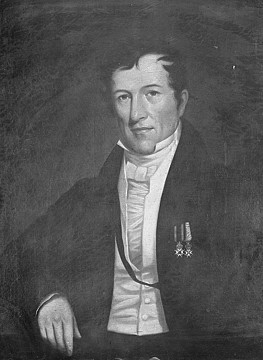Thomas Dixon (1781-1849)
K.N.L., Merchant & Consul-General of the Netherlands, Boston
He was born in Westminster, London, and accompanied his parents to the Netherlands in 1788. He received a commission into the British Army from Viscount Melville but it was intercepted by the French and he was sentenced to be executed. On being released on bail, he fled before being arrested again, this time bribing the chief of police with a thousand francs to be set free. As a merchant in the early 1800s in Ostend, he successfully rescued about thirty or forty English captains and seamen, "and procured their passages home at his own expense, and at great risk to himself". In 1808, he was appointed a Magistrate at Flushing and was Chairman of the Chamber of Commerce. In 1809, on hearing news that the French were preparing fire-boats to burn the British Fleet, he alerted the Admirals and in doing so saved 155-boats.
Napoleon visited Flushing in 1810, and in his role as Magistrate Dixon showed him around the town and in turn the Emperor presented him with keys to the city - only to have him arrested by Special Order the following day. Dixon spent the next fifteen months in prison in Paris before an influential friend succeeded in having him exiled to Macon in Burgundy. He was ordered to sell all his property in Holland and to invest there, where he remained until 1814. He then returned to Flushing by way of Basel in Switzerland and The Hague - dining along the way with various members of Royalty - and was reinstated as Magistrate.
After the Battle of Waterloo (1815), Dixon returned to Holland and became a partner in the mercantile house of van Braggen, Parker & Co. that traded principally with the United States, where he embarked in 1816. It was while he was in Boston in 1818 that he married Mary, "the celebrated" daughter of East India merchant Benjamin Perrott Homer. It was said Dixon, "has skill in music, and can play many droll tricks". They returned to London and were received by the French Royal Family in Paris before stopping off to see Dixon's parents in Flushing. For the next four years they lived in Amsterdam before returning to Boston where they remained for the rest of their lives and from 1833 Dixon served as the Dutch Consul before being made a Knight of the Order of the Netherlands Lion. In 1848, his fortune was estimated at $100,000. In addition - but independent of his own fortune - his wife was the sole beneficiary of a $150,000 trust established by her father.
After the death of Thomas L. Winthrop, Dixon purchased No. 1 Walnut Street (see image) where he lived with his family until his death in 1849. The Dixons eldest son built Farley and was the grandfather of the builder of Ronaele Manor; their second son lived at The Homewood; and their daughter lived at The Grange. In 1858, his widow removed to Toronto with their eldest son and after being thrown from her carriage died there in 1875.
Napoleon visited Flushing in 1810, and in his role as Magistrate Dixon showed him around the town and in turn the Emperor presented him with keys to the city - only to have him arrested by Special Order the following day. Dixon spent the next fifteen months in prison in Paris before an influential friend succeeded in having him exiled to Macon in Burgundy. He was ordered to sell all his property in Holland and to invest there, where he remained until 1814. He then returned to Flushing by way of Basel in Switzerland and The Hague - dining along the way with various members of Royalty - and was reinstated as Magistrate.
After the Battle of Waterloo (1815), Dixon returned to Holland and became a partner in the mercantile house of van Braggen, Parker & Co. that traded principally with the United States, where he embarked in 1816. It was while he was in Boston in 1818 that he married Mary, "the celebrated" daughter of East India merchant Benjamin Perrott Homer. It was said Dixon, "has skill in music, and can play many droll tricks". They returned to London and were received by the French Royal Family in Paris before stopping off to see Dixon's parents in Flushing. For the next four years they lived in Amsterdam before returning to Boston where they remained for the rest of their lives and from 1833 Dixon served as the Dutch Consul before being made a Knight of the Order of the Netherlands Lion. In 1848, his fortune was estimated at $100,000. In addition - but independent of his own fortune - his wife was the sole beneficiary of a $150,000 trust established by her father.
After the death of Thomas L. Winthrop, Dixon purchased No. 1 Walnut Street (see image) where he lived with his family until his death in 1849. The Dixons eldest son built Farley and was the grandfather of the builder of Ronaele Manor; their second son lived at The Homewood; and their daughter lived at The Grange. In 1858, his widow removed to Toronto with their eldest son and after being thrown from her carriage died there in 1875.






